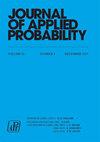连续时间保守随机游走的短暂性
IF 0.7
4区 数学
Q3 STATISTICS & PROBABILITY
引用次数: 0
摘要
我们考虑了英格兰德和沃尔科夫(2022)引入的保守随机漫步的两种连续时间广义模型,一种是正交模型,另一种是球对称模型;后一种模型也被称为随机飞行。对于这两种模型,我们都证明了当$d\ge 2$时随机游走的瞬时性,并且方向改变的速率遵循幂律$t^{-\alpha}$ ,$0<\alpha\le 1$,或律$(\!\ln t)^{-\beta}$ (其中$\beta>2$)。本文章由计算机程序翻译,如有差异,请以英文原文为准。
Transience of continuous-time conservative random walks
We consider two continuous-time generalizations of conservative random walks introduced in Englander and Volkov (2022), an orthogonal and a spherically symmetrical one; the latter model is also known as random flights . For both models, we show the transience of the walks when $d\ge 2$ and that the rate of direction changing follows a power law $t^{-\alpha}$ , $0<\alpha\le 1$ , or the law $(\!\ln t)^{-\beta}$ where $\beta>2$ .
求助全文
通过发布文献求助,成功后即可免费获取论文全文。
去求助
来源期刊

Journal of Applied Probability
数学-统计学与概率论
CiteScore
1.50
自引率
10.00%
发文量
92
审稿时长
6-12 weeks
期刊介绍:
Journal of Applied Probability is the oldest journal devoted to the publication of research in the field of applied probability. It is an international journal published by the Applied Probability Trust, and it serves as a companion publication to the Advances in Applied Probability. Its wide audience includes leading researchers across the entire spectrum of applied probability, including biosciences applications, operations research, telecommunications, computer science, engineering, epidemiology, financial mathematics, the physical and social sciences, and any field where stochastic modeling is used.
A submission to Applied Probability represents a submission that may, at the Editor-in-Chief’s discretion, appear in either the Journal of Applied Probability or the Advances in Applied Probability. Typically, shorter papers appear in the Journal, with longer contributions appearing in the Advances.
 求助内容:
求助内容: 应助结果提醒方式:
应助结果提醒方式:


